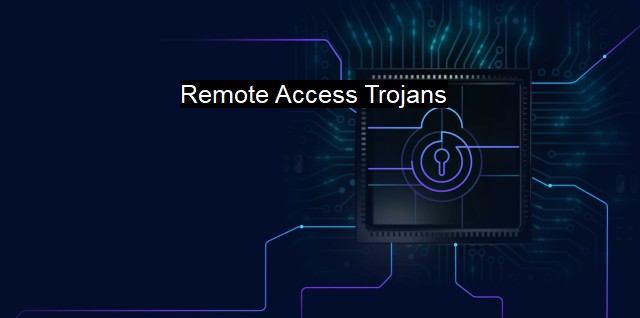What are Remote Access Trojans?
Remote Access Trojans (RATs): The Emerging Cybersecurity Threat Impacting Telecommuting and Business Infrastructure
Remote Access Trojans (RATs) are a type of malicious software targeted primarily at computers running on Windows. They allow cyber attackers to control the infected computers or networks from a remote location, hence the name. These Trojans are amongst the most invasive types of malware, potentially allowing hackers to manipulate a system as if they had physical access to it. Rat's effects can be extensive and harmful, stretching from file corruption to loss of critical personal or business data. The cybersecurity community often includes the study of RATs when designing protective measures such as antivirus software, due to their highly invasive and potentially devastating capacities.RATs can be covertly installed on a user's system using various methods, such as packaged downloads, phishing attacks, or fraudulent websites. Once installed, these Trojans operate stealthily, hiding their processes under the likeness of familiar or trusted systems to avoid detection. Part of what makes RATs highly innovative and hazardous is their capacity to propagate and install themselves without significant user interaction, making them difficult to detect and remove.
The remote control abilities of a RAT can range from the practical, such as file manipulation and installation or uninstallation of software, to the worrying, which might encompass keylogging, webcam control, and even the recording of screen activity. With more advanced RATs, the extent of accessible resources and available maneuvers might be so all-encompassing that a user's entire digital life could potentially be exposed to and controlled by the attacker.
Like other types of malicious software, RATs are created and used for various purposes, ranging from financial gains to corporate espionage. They take advantage of computer systems’ vulnerabilities, weaknesses in software, or human error to infiltrate and assume command. Threat actors profusely use them for information theft, particularly when the information could be valuable for identity theft and financial fraud.
Not every RAT instantaneously aims for a high-impact attack. Some reports show evidence of cybercriminals infesting systems and waiting for an opportune time before fully activating the RAT's capabilities. Periodically, they act as a form of surveillance, with the keylogging feature quietly noting down user input and movements before actually initiating an attack.
In relation to cybersecurity measures against RATs, traditional antivirus software can often prove lacking. This is due to the inherent stealth and adaptability those Trojans display, continually modifying their signatures to remain untraceable. Hence, even if the antivirus software can detect certain instances, the rapid evolution of these Trojans means that they often escape unnoticed.
Modern cybersecurity measures have evolved to counter this threat effectively. Measures such as heuristic analysis, behavior-based detection, and advanced threat detection that aim to identify malicious behaviors in real-time, rather than simply seeking out known signatures, have shown promise against RAT attacks. Combined with regular system checks and critical security updates, these measures contribute to creating a multi-pronged defense against the RAT menace.
Education and awareness about well-known RAT infection mechanisms, such as the danger of downloading unverified software or clicking dubious links, play a crucial role in securing individual and network safety.
The threat presented by RATs is undoubtedly serious due to their highly invasive and versatile nature. as frightening as the concept of a Remote Access Trojan might be, nascent measures in cybersecurity and antivirus technology have proven to be effective shields against such threats. Through a combination of technological countermeasures and informed practice, individuals and businesses can largely secure themselves from RATs' dangers.

Remote Access Trojans FAQs
What is a remote access Trojan (RAT)?
A remote access Trojan (RAT) is a type of malware that allows cybercriminals to gain unauthorized remote access to a victim's computer system, often without the victim's knowledge. Once the RAT has infected a system, the attacker can use it to monitor activity on the device, steal sensitive data and credentials, and even gain full control over the system.How does a RAT infect a computer system?
RATs are often delivered via phishing emails, booby-trapped email attachments, or malicious downloads from the internet. Once the victim clicks on a link or opens an attachment containing the RAT, it silently installs itself on the victim's computer and begins communicating with the attacker's command-and-control center.What are the signs of a RAT infection?
Some common signs of RAT infection include a slow or sluggish computer performance, unexplained changes to system settings, and unauthorized access to files or applications. Additionally, victims may notice strange or unfamiliar processes running in the background or unusual network activity.How can I protect myself against RAT attacks?
To protect against RAT attacks, users should practice good cyber hygiene habits such as keeping their operating systems and software up-to-date, using strong and unique passwords, and avoiding suspicious email attachments or links. Additionally, users can install reputable antivirus and anti-malware software to help detect and remove RATs before they can do harm.| | A | | | B | | | C | | | D | | | E | | | F | | | G | | | H | | | I | | | J | | | K | | | L | | | M | |
| | N | | | O | | | P | | | Q | | | R | | | S | | | T | | | U | | | V | | | W | | | X | | | Y | | | Z | |
| | 1 | | | 2 | | | 3 | | | 4 | | | 7 | | | 8 | | |||||||